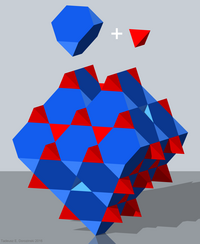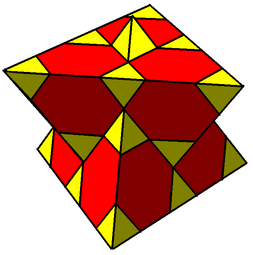Cyclotruncated tetrahedral-octahedral honeycomb
Jump to navigation
Jump to search
| Cyclotruncated tetrahedral-octahedral honeycomb | |
|---|---|
 | |
| Rank | 4 |
| Type | Uniform |
| Space | Euclidean |
| Notation | |
| Bowers style acronym | Cytatoh (old: Batatoh) |
| Coxeter diagram | x3x3o3o3*a ( |
| Elements | |
| Cells | N tetrahedra, N truncated tetrahedra |
| Faces | 4N triangles, 2N hexagons |
| Edges | 6N |
| Vertices | 2N |
| Vertex figure | Triangular antiprism, edge lengths 1 (base) and √3 (sides) |
| Measures (edge length 1) | |
| Vertex density | |
| Related polytopes | |
| Army | Cytatoh |
| Regiment | Cytatoh |
| Dual | Triangular antitegmatic honeycomb |
| Conjugate | None |
| Abstract & topological properties | |
| Orientable | Yes |
| Properties | |
| Symmetry | P4×2 |
| Convex | Yes |
| Nature | Tame |
The cyclotruncated tetrahedral-octahedral honeycomb, also known as the quarter cubic honeycomb, is a convex uniform honeycomb. 2 tetrahedra and 6 truncated tetrahedra join at each vertex of this honeycomb. It can be formed by applying two successive alternated faceting to the cubic honeycomb. It is related to the mutetrahedron, whose faces are exactly its hexagonal faces.
Representations[edit | edit source]
A cyclotruncated tetrahedral-octahedral honeycomb has the following Coxeter diagrams:
- x3x3o3o3*a (


 ) (full symmetry)
) (full symmetry) - s4o3x o3*b (




 ) (as single alternated faceting)
) (as single alternated faceting) - β4o3o4s (






 ) (as double alternated faceting)
) (as double alternated faceting)
Gallery[edit | edit source]
-
Wireframe
-
Slab
-
External links[edit | edit source]
- Klitzing, Richard. "cytatoh".
- Wikipedia contributors. "Quarter cubic honeycomb".
- Binnendyk, Eric. "Category 7: Triangular Podiumverts" (#140).



